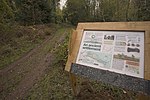Goblin Combe

Goblin Combe is a dry valley in North Somerset which stretches for approximately 3½ km from Redhill, near Bristol International Airport on the A38, through to Cleeve on the A370. The combe is located at (grid reference ST473652), and is a 52-hectare (128-acre) biological Site of Special Scientific Interest (SSSI) originally notified in 1999, with 9 hectares (22 acres) being managed as a nature reserve by the Avon Wildlife Trust. The Combe runs along the southern edge of a large woodland. "Combe" is the same as the Welsh word "cwm" which means valley. Above the valley is Cleeve Toot an Iron Age hillfort. It is a roughly oval settlement which is approximately 125 metres (410 ft) in length by 90 metres (300 ft) in breadth. Approximately 150 metres (490 ft) to the north is another, smaller settlement. They are thought to have been a satellite community of nearby Cadbury Hill Pits have been found at the site indicating the presence of round houses. There is a single stone rampart with a broad shallow outer ditch. There is also a prehistoric or Roman field system.
Excerpt from the Wikipedia article Goblin Combe (License: CC BY-SA 3.0, Authors, Images).Goblin Combe
Cox's Loop,
Geographical coordinates (GPS) Address Nearby Places Show on map
Geographical coordinates (GPS)
| Latitude | Longitude |
|---|---|
| N 51.383 ° | E -2.759 ° |
Address
Cox's Loop
Cox's Loop
BS40 5PP
England, United Kingdom
Open on Google Maps







